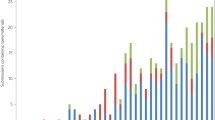Abstract
Nanotechnology, as with many technologies before it, places a strain on existing legislation and poses a challenge to all administrative agencies tasked with regulating technology-based products. It is easy to see how statutory schemes become outdated, as our ability to understand and affect the world progresses. In this article, we address the regulatory problems that nanotechnology posses for the Food and Drug Administration’s (FDA) classification structure for “drugs” and “devices.” The last major modification to these terms was in 1976, with the enactment of the Medical Device Amendments. There are serious practical differences for a classification as a drug or device in terms of time to market and research. Drugs are classified, primarily, as acting by “chemical action.” We lay out some legal, philosophic, and scientific tools that serve to provide a useful, as well as legally and scientifically faithful, distinction between drugs and devices for the purpose of regulatory classification. These issues we raise are worth the consideration of anyone who is interested in the regulation of nano-products or other novel technologies.
Similar content being viewed by others
Notes
The ultimate resolution of how to incorporate new scientific knowledge and new product types into statutory and regulatory systems resides with Congress. Congress often takes many years to act after major scientific changes or advances. The concepts we set forth in this article are directed at the regulatory agencies, which must deal with outdated statutes. However, these concepts could also form the basis for Congressional action to address the impact of new scientific knowledge and new products.
For example, nanoparticle silver coatings on implants are viewed as devices, while nanosphere-based drug delivery systems are considered drugs.
FDA generally does not regulate the practice of medicine. See, for example, 21 USC §396. Also, dietary supplements and certain foods can make health claims without being considered drugs, devices, or biologics. 21 USC §343(r) sets forth some requirements for foods making health claims. For our purposes, these exceptions will not be discussed in any detail.
“New drugs” are defined under 21 U.S.C. §321(p) and, generally speaking, including any new compound or new use of an old compound that came into existence after 1938.
For our purposes, the metabolism element is not relevant. We do point out the, perhaps inappropriate, use of the “and” connector between the “chemical action” clause and the metabolism clause. In general usage, this has been interpreted as meaning “or.”
There was some pending device-specific legislation around the same time as the 1962 drug amendments. Perhaps because of the challenge posed by thalidomide, the drug amendments were passed, but the proposed device amendments languished.
Physicalism is a term that can be traced back to Otto Neurath (2000).
References
74 Cong. Rec. 4811-12 (April 2, 1935) (statements of Senator Clark)
121 Cong. Rec. 10688, 10690 (April 17, 1975) (testimony by Joseph B. Davis, Director, Scientific Review of the HEW Office of Medical Devices in remarks of Sen. Nelson)
Chevron U.S.A., Inc. v. National Resources Defense Council, Inc., 467 U.S. 837 (1984)
Eells E (1991) Probabilistic causality. Cambridge University Press, New York, NY
Food and Drug Administration (FDA) (1997) Reauthorization of FDA’s Medical Device Program. Statement of Michael Friedman before the House Committee on Commerce, Subcommittee on Health and Environment. http://www.fda.gov/NewsEvents/Testimony/ucm114951.htm. Accessed 24 Nov 2010
Food and Drug Administration (FDA) (2009) Council for responsible nutrition annual symposium for the dietary supplement industry. Remarks of Joshua M. Sharfstein. http://www.fda.gov/NewsEvents/Speeches/ucm187640.htm. Accessed 24 Nov 2010
Fodor J (1990) Why there still has to be a language of thought. In: Artificial intelligence—a source book. Cambridge University Press, Cambridge
Hutt PB, Merrill RA, Grossman L (2007) Food and drug law: cases and materials. Foundation Press, New York, NY
Lombardi O, Labarca M (2005) The ontological autonomy of the chemical world. Found Chem 7:125–148
Merriam-Webster’s Medical Dictionary s.v. “chemistry” (2007) Merriam-Webster, Inc., Springfield, MA
Merrill RA (1996) The architecture of government regulation of medical products. Virginia Law Rev 82:1753–1866
Neurath O (2000) Physicalism. In: Lindberg JJ (ed) Analytic philosophy: beginnings to the present. McGraw-Hill, New York, NY
Nye MJ (1993) From chemical philosophy to theoretical chemistry: dynamics of matter and dynamics of disciplines, 1800–1950. University of California Press, Berkeley, CA
Rai M, Yadav A, Gade A (2009) Silver nanoparticles as a new generation of antimicrobials. Biotechnol Adv 27:76–83
Singh M, Singh S, Prasad S, Gambhir IS (2008) Nanotechnology in medicine and antibacterial effect of silver nanoparticles. Dig J Nanomater Biostruct 3:115–122
Senate Report 361, 74th Cong., 1st sess. (1935)
Senate Report 493, 73rd Cong., 2d Session (1934)
Senate Report 513, 101st Cong., 2d Session (1990)
Sober E (2000) Philosophy of biology. Westview Press, Boulder, CO
United States v. Bacto-Unidisk, 394 U.S. 784 (1969)
Webster’s New International Dictionary of the English Language s.v. “chemistry” (1912) G. & C. Merriam Company, Springfield, MA
Acknowledgments
Preparation of this article was supported by National Science Foundation (NSF) grant #0608791, “NIRT: Evaluating Oversight Models for Active Nanostructures and Nanosystems: Learning from Past Technologies in a Societal Context” (Principle Investigator: S.M. Wolf; Co-PIs: E. Kokkoli, J. Kuzma, J. Paradise, and G. Ramachandran). The views expressed are those of the authors and do not necessarily reflect the views of NSF. The authors wish to extend special thanks to Saurabh Anand for his invaluable assistance in the underlying research and assessment of differing approaches to this issue.
Author information
Authors and Affiliations
Corresponding author
Rights and permissions
About this article
Cite this article
Koolage, W.J., Hall, R. Chemical action: what is it, and why does it really matter?. J Nanopart Res 13, 1401–1417 (2011). https://doi.org/10.1007/s11051-011-0253-y
Received:
Accepted:
Published:
Issue Date:
DOI: https://doi.org/10.1007/s11051-011-0253-y




